
20 February 2017. Sitting on the wooden bench seats of the horse-drawn cart, as we trot along the red dirt track surrounded by tobacco fields,
I say to Carlos in my halting Spanish Sabe palabra “exotic”? I now know that what I’ve said is “knows word exotic?” No wonder there’s a slight hesitation, and then he replies Si si exotique! I say to him Todo aqui para usted es normal, everything here for you is normal, as I wave my arms around the valley. Si si normal he says and I reply Para mi es exotique. For me it’s exotic. His face lights up. It’s as if a penny has dropped. We feel closer, have a friendlier connection, and understand each other a little better. It is such a wonderful thing to have a smattering of the local language. Perhaps it will make it easier for him when he drives other tourists around the valley, though he seems so easy-going that he probably just enjoys himself anyway. We’d asked for a farmer to take us around, but of course farmers are busy farming. Carlos and his brother own horses so they are hired to work on farms. And to drive tourists around the valley. Which probably pays much better.
It turns out to be one of our best days in Cuba; a really magical day that I’ll always remember.
The day before we’d stood in line in a tourist agency on the main street. We didn’t know if it would even be possible or not, but we wanted to get off the roads and tour the valley in one of the local horse-drawn carts. We didn’t want a tourist buggy. We wanted to go with a farmer in one of the unique carts they use in the region. I’ve not seen anything like them anywhere else. They have a rectangular metal “container” for your feet and whatever else is being hauled, with a wooden seat along either side of the top of the container so you’re forced to sit sideways. I wonder why they developed this way – this sitting sideways. Every other cart I’ve ever seen anywhere in the world is designed so the driver can face forward.
The day starts as a bit of a challenge. We wait with our vouchers out the front of the tourist office engulfed by the crowd of fellow tourists lined up to get to talk to someone inside, or waiting, like us, to be connected with their tour for the day. A man approaches and asks if we’re there for the horse and cart ride. He takes our vouchers and heads off down the street. After several blocks we start to wonder what’s going on and Don asks sharply Where are we going? It turns out there are no carts allowed on the main street. Eventually our guide takes us to our ride for the next three hours.
From Don: We clamber on board, and sit sidesaddle on the wooden plank seat, while the driver sits on the other side. We introduce ourselves with the usual Como se llama? and he tells us that his name is Carlos and his horse is called Toranado. Tornado. Okay. We smile at the name, hoping it’s not literal. Then we are off up the road out of town, and then off the road and onto a cart track past fields of yucca 
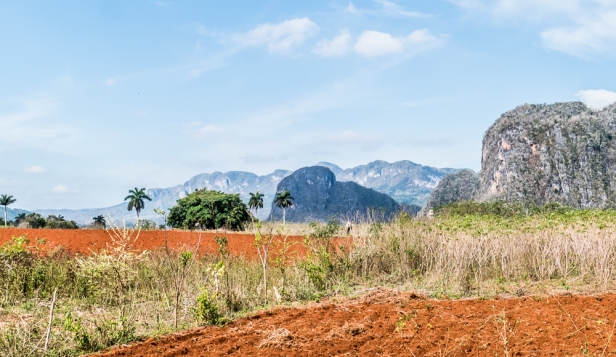
and tobacco plants.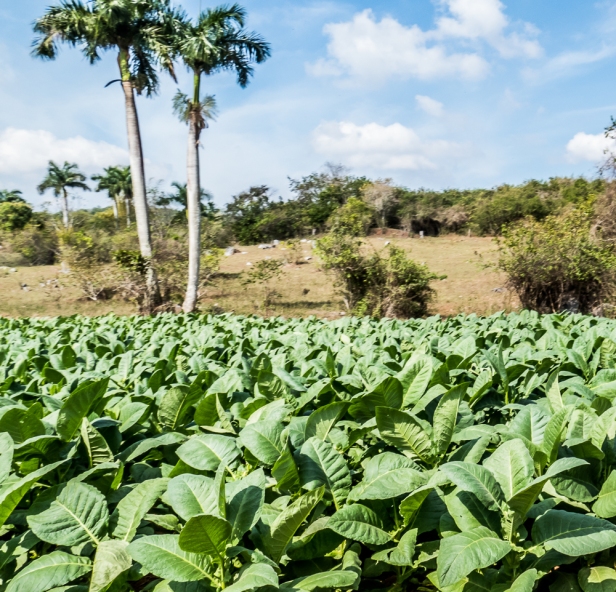

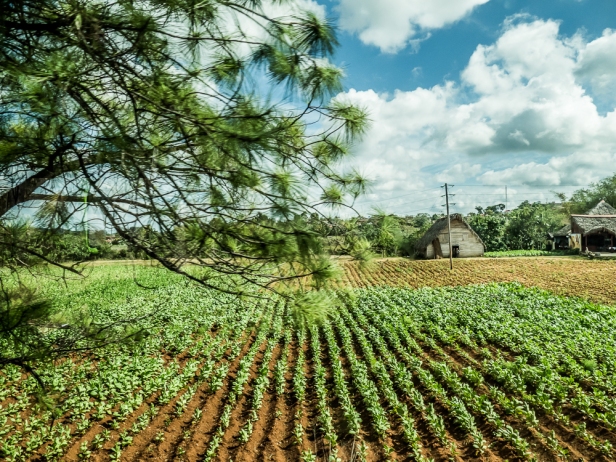
The scenery is spectacular, with large rock formations rising straight up out of the otherwise flat plain, and behind them more serious hills. We trot along, with Toranado doing a great job of pulling us up and down rutted cart tracks, with only the occasional complaint when he simply stops and refuses to move until a gentle smack across his back with the lead rope gets him going again.
The province of Pinar del Rio occupies the westernmost end of Cuba as it curves gently towards Mexico. Here is grown the very best tobacco in the world, in the Vuelta Abajo and Villa Cara regions, as well as in the Valle de Viñales. The cigars made from this tobacco are an iconic and world-renowned part of Cuban culture. The farmers of the Valle de Viñales, which we are exploring with Carlos, claim their tobacco is the best of all since it is grown within a national park so chemical fertilizers are forbidden. It is all organic, grown on small plots of land in the nutrient-rich red loam that covers this part of the country, and it is all farmed by hand. By law ninety percent of it is sold to the government.
The rugged mogotes or limestone bluffs, the red earth, the lush green of the plants,
and the plows pulled by a pair of oxen and steered by a vaguero all tell us we have arrived in the real Viñales, the Viñales of the local tobacco farmer.
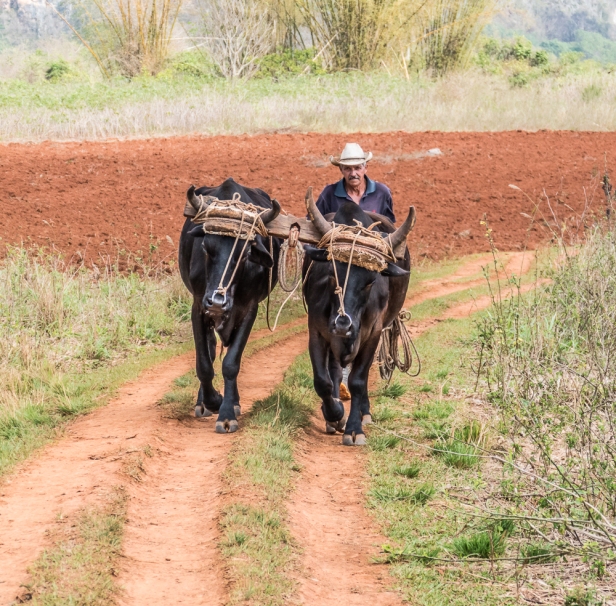

There are thatched sheds for drying the tobacco scattered throughout the region,


and small neat farm houses.
We stop at one of the farms where we are introduced to the farmer and one very territorial turkey.

In the curing shed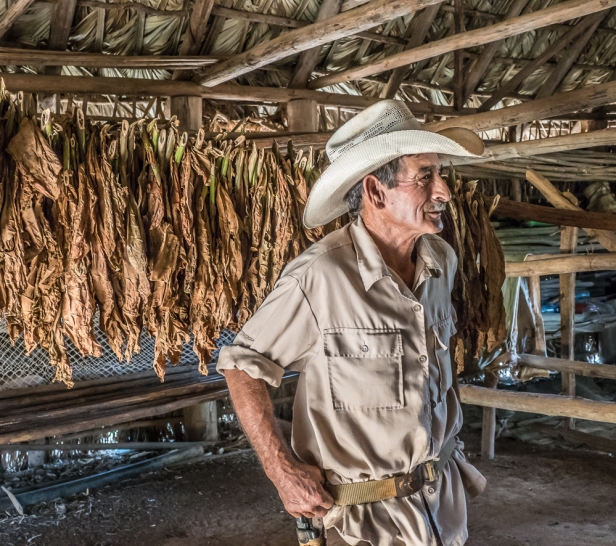
we are told about the tobacco growing, drying, and curing process, and shown some hand-rolled cigars. Leaves are hung to dry for about six or seven weeks. After that it gets ridiculously complex with wrapper, filler, and binder leaves all undergoing different lengthy fermentation processes. The leaves are then hand rolled in a factory by experts. We didn’t see a cigar factory in Cuba, but we did visit one in Myanmar where cigars are equally popular. With flying hands and expert precision a cheroot maker in Myanmar can produce 100 hand-rolled cheroots per hour. Making a Cuban cigar is a much more complicated process because of the number of different leaves used, and the specific layering of the leaves. Nevertheless, a Cuban cigar maker can still manage to produce 100 per day.
Some time after leaving the farm we come to a “bridge”. Carlos tells us we have to get down from the cart and walk across it. The bridge is precarious,
but we are happy to walk across it when we see Carlos will be taking the horse and cart down into a very steep and narrow gully and up the equally steep opposite side. Continuing on we pass more vagueros (cowboys)
and eventually come to the next stop where Carlos encourages us to climb down from the cart and climb up a hill. At the top we are rewarded with a cool drink from the girl at the simple wooden concession stand, and fabulous views.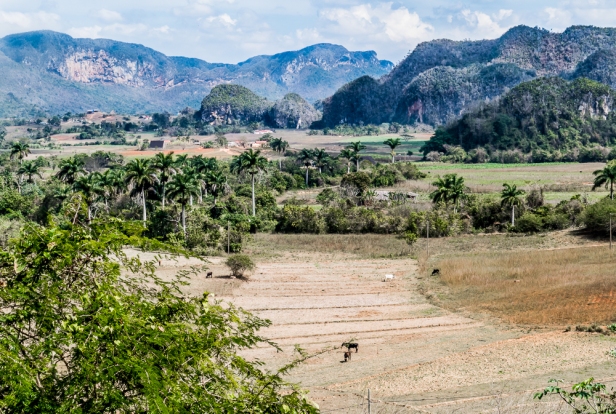

Travelling on we eventually come back to the road, and traffic,
and so back into town.
After a rest we decide to get a taxi to Las Jazmines (The Jasmines), a luxury hotel high on a hill at the edge of town. We are hoping for some Wi-Fi time and to have dinner there. As it turns out the Wi-Fi is slow, and it’s cooler than expected and we don’t have our jackets with us, so we end up having dinner in town. What we do get at Las Jazmines are views of the dazzling scenery
and a little later as the light changes
a magnificent sunset.
Viñales in the second most visited place in Cuba after Havana, and it’s not hard to understand why. Activities range from rock climbing, to horseback riding, to caving, to hiking, in some of the most spectacular scenery in the world. But it’s more than that. There’s something special about the place. There’s a relaxed easy feeling that’s missing in the city, as if peace arises from the earth itself and everybody is invited to take a share. We loved it there and could have happily stayed longer.
Next post: Perhaps something about settling into life in Vancouver. Or perhaps something about Trinidad, our next stop in Cuba.
All words and images by Alison Louise Armstrong unless otherwise noted
© Alison Louise Armstrong and Adventures in Wonderland – a pilgrimage of the heart, 2010-2017.

You’re photos are just amazing, I’m arriving from one month in Cuba but didn’t go to Viñales, maybe it was a mistake 😉
LikeLiked by 1 person
Thanks so much Ana. Well perhaps just a tiny mistake that you didn’t go there 😉
Viñales was a very special time for us. Perhaps you’ll go back to Cuba one day and then go to Viñales.
Alison
LikeLiked by 1 person
Alison and Don – Your post and photos are stunning! I could feel the textures, smell the tobacco growing in the fields, and taste the cool drink at the top of the hill. I look forward to your next post (my vote is for one on settling into life in Vancouver)!
LikeLiked by 1 person
Thank you so much Donna. It’s the best compliment that I managed to convey something of the flavour of the place. We loved it there.
Alison
LikeLiked by 1 person
Reblogged this on World4Justice : NOW! Lobby Forum..
LikeLiked by 1 person
Thanks so much for the reblog.
Alison
LikeLike
i love Cuba and Viñales…my heart aches for my Cuban friends who have so little i hope Canada will be assist them…and we all go there soon to support them…lovely post again Alison thank you for sharing 😀 ❤
LikeLiked by 1 person
Thanks Hedy. We also love Viñales – such a beautiful place. I do hope things begin to turn around for Cuba, though the recent hurricane didn’t help 😦
At least Raúl is interested in developing the economy.
Alison
LikeLiked by 1 person
Great post, magical pictures. I thoroughly enjoyed it.
LikeLiked by 1 person
Thank you so much Maria. I’m glad you enjoyed it. It was fun for me to put it together.
Alison
LikeLike
No doubt about you guys you always do it differently. Looks like a wonderful day you, Carlos and Toranado. Glad he didn’t live up to his name, I always learn something from your posts Alison. I wonder how this part of the country went with all of the flooding. We’re off to Italy tomorrow for three weeks with our daughters with two weeks in Italy, Special trip for us spending a week in my husband’s home town near Syracusa. Hope you are both well. Louise
LikeLiked by 1 person
Thanks Louise. It was a wonderful day, one of the highlights of the trip to Cuba. As far as I know the hurricane damage was along the north coast so a long way from Viñales, though no doubt they would have gotten a lot of rain from it.
Have an awesome time in Italy! I look forward to posts about it.
Alison
LikeLike
I love it to go on that virtual journey with you, guys. Always amazing, a great read, wonderful photos and so inspiring. 🙂
LikeLiked by 1 person
Thanks Carsten. It’s great to have you along!
Alison
LikeLiked by 1 person
It is always a pleasure to read your posts!!! 🙂
LikeLiked by 1 person
Reading your post and looking at your pictures is making my heart flutter 🙂 I can feel a deep connection to Cuba and can’t wait to experience my own journey next spring. Your photos, on their own tell such a beautiful story. I love all of them but I particularly like the photo of the farmer with the tobacco hanging to dry.
LikeLiked by 1 person
Thank you so much Pru. Overall Cuba is amazing. Not always easy but still a quite extraordinary place and definitely worth visiting. I’m sure you’ll have a fabulous time there, especially since you feel a deep connection to it. Thanks re the photos, and the farmer – he’s definitely typical.
Alison
LikeLike
I feel like you followed us! From the crazy tourist office, trying to set up our own little custom activities, to the tobacco farms and the drying sheds, to Los Jazmines, where we got dropped off to catch a trailhead down into that gorgeous landscape. Your photos are light years beyond what I was able to get, and it’s so fun to see that wonderful little town all over again.
LikeLiked by 1 person
Thanks Lexie. Not only did I follow you, but I stole your title without even knowing it 🙂
I just went back to have another look at your post – the title must have stuck in my subconscious. I think your photos are quite fine!
I wish we could have been dropped at a trailhead to go hiking but alas I was unable to walk far at all while we were there so Toranado had to be our legs.
Alison
LikeLiked by 1 person
I’m sure there are many of us who have used that title to describe our time in Viñales!
LikeLiked by 1 person
Wonderful photos and commentary. We didn’t know this was an option when we were there. Fantastic post. Thanks.
LikeLiked by 1 person
Thanks so much Peggy. I don’t think it’s advertised as an option. I just went into one of the tour agencies and asked for it, not knowing if it was even possible.
Alison
LikeLike
How fantastic that you were able to get off the beaten track and out into the realCuba. Your photos as always are Nat Geo quality in my opinion. They transport me to the horse and buggy as if I am seeing it for myself. Brilliant.
LikeLiked by 1 person
Thanks Sue. You say the nicest things! As we travelled the valley by bus the day before I was really clear that I wanted to get off the roads and into the fields in one of those local horse-drawn carts. Turns out it was doable, and one of the best things we did.
Alison
LikeLiked by 1 person
The landscape really is exotic – and spectacular and whatever other superlatives come to mind! This truly looks like the land that time forgot with the horse drawn carts, plows pulled by oxen and the one lone ancient car in your photos. I remember feeling like this occasionally during our time in Nicaragua and your pictures show a place far removed from anything in the modern world. You’ve definitely captured that special moment in time, Alison and I can understand why you say this day will be a special memory to hug in your heart. Anita
LikeLiked by 1 person
Thanks Anita – I’m glad I was able to capture something of the spirit of the place – the fact that there are so many tourists and yet they continue with the old ways while benefiting from the tourist dollars. Once you get away from the main street there’s a special energy in the whole region. That ride with Carlos was so peaceful.
Alison
LikeLike
It’s definitely another world, isn’t it? Astounding scenery! You feel you could just gently jog along forever. I don’t suppose the hurricane has affected this area much? It’s been so devastating, Alison! Thanks for a beautiful share. 🙂
LikeLiked by 1 person
Thanks Jo, and you’re welcome. I did feel as if I could just jog along forever, and was a bit disappointed when we came back out to the road again. The worst of the hurricane was along the north coast so a few hundred km from Viñales, but no doubt they got a lot of rain from it.
Alison
LikeLiked by 1 person
What stunning photographs you were able to capture here!! <3<3<3
LikeLiked by 1 person
Thank you so much Finja. I’m glad you like them.
Alison
LikeLiked by 1 person
Thank you so much for taking us touring along the country paths and byways. Wonderful images.
LikeLiked by 1 person
Thanks Tish. It was a pleasure – to live it and then to share it. Such a beautiful place. Apparently it was Fidel’s favourite place in Cuba, which is not surprising.
Alison
LikeLiked by 1 person
Such a heartwarming post about this picturesque part of Cuba, Alison! The landscape reminds me a little bit of what I saw in South Sulawesi, karst peaks as far as the eyes could see. And that precarious bridge, I walked over that kind of bridge a lot when I grew up! 🙂 I wonder if going to Viñales would make me feel at home.
LikeLiked by 1 person
Thanks Bama. I’m sure I’d love South Sulawesi! As I did Ha Long Bay in Vietnam. Karst landscapes are so beautiful. Somehow I’m not surprised to hear you’re familiar with that kind of bridge so I do think you’d feel at home in Viñales.
Alison
LikeLiked by 1 person
So beautiful! I’m kicking myself that we didn’t make it to Vinales. Would have loved to see this part of the country. Love the photo of the man in the drying shed. Curious point about the side-facing horse carts! Great post.
LikeLiked by 1 person
Thanks Kelly. You’re the second person to pick out the photo of the vaguero in the drying shed. I guess it’s somehow iconic or something. If you ever go back to Cuba make sure you go to Viñales – rock climbing, caving, hiking, horse-back riding, beautiful scenery. I bet you two would love it!
Alison
LikeLiked by 1 person
I love your sense of adventure Alison. I would have never considered taking a horse-drawn cart through the fields and country lanes, but is seems that is the perfect mode of transportation for seeing the traditional landscape. I love all your photos but have to agree with other readers that the vaguero in the drying shed really spoke to me.
LikeLiked by 1 person
Thanks so much LuAnn. It was definitely the perfect way to see the farms and the valley, though I do wish I’d been able to do a little hiking in the area as well. Next time 🙂
I had no idea the vaguero in the drying shed would be so popular. I guess I captured something that I didn’t even recognise myself.
Alison
LikeLiked by 1 person
It is really beautiful Alison.I really like the contrast of the plains and rocks.
Interesting on the cigars, particularly the fact that so much of the crop has to be sold to the government. I suspect that the farmers would be much better off if they could sell their tobacco commercially. One of the advantages of a cash crop like tobacco (or marijuana where I live) is that the value is high enough that small farmers can make a living off of it.
I noted that your cart came with rubber tires and a very interesting approach to springs. Was the ride smooth? A couple of hours on a wooden seat can be a bit of a challenge. 🙂 –Curt
LikeLiked by 1 person
It was three hours, with a couple of short breaks, over some pretty rough tracks, but I don’t at all remember it being all that uncomfortable. I was so engrossed in the experience, and in photographing, that I didn’t notice I guess. All the carts have rubber tires. And probably the same springs – though I didn’t look at that 🙂
It’s Cuba so the Govt controls just about everything 🙂
And yes, a really beautiful part of the world.
LikeLike
My tailbone has much less tolerance now than it used to!
“Govt controls just about everything” Not much incentive for high productivity. 🙂
LikeLiked by 1 person
No, but I think tobacco farming is one occupation in Cuba where the farmers enjoy and take pride in their work. Cigars are such a deep and iconic part of the national psyche, and they know they’re the best in the world, so I think that helps a lot. Other occupations not so much.
LikeLike
Good point, Alison.
LikeLiked by 1 person
I should also note that the pot farmer who camped next to me at Burning Man was extremely proud of his product. He insisted that I sample it. 🙂
LikeLiked by 1 person
Chuckle. Insisted . . . . . .
LikeLike
🙂
LikeLiked by 1 person
Apparently Don noticed that the ride was challenging 🙂
LikeLike
I’d be with Don, regardless of how fascinated I was with the photography. 🙂
LikeLiked by 1 person
It was still a good deal, not a bum deal! 🙂
LikeLike
Not bum buns, in other words… 🙂
LikeLike
🙂
LikeLiked by 1 person
No buns were numbed in the making of this blogpost.
LikeLiked by 1 person
Good news!
LikeLiked by 1 person
What a wonderful way to spend three hours. It looks stunning.
LikeLiked by 1 person
It was a really special time. I felt so relaxed, and the landscape is so beautiful. I felt like I was seeing the real Viñales.
Alison
LikeLike
That’s really special.
LikeLiked by 1 person
Vinales seems a world away from the hustle of Havana! Hadn’t realised the landscape was this beautiful. Love the warm tones in your photos Alison. ‘In the curing shed’ is stunning. As are the dramatic sunsets.
LikeLiked by 1 person
I edited your post for you 🙂
It is definitely a world away from Havana. I’d seen pictures, but was still entranced by the beauty of the landscape when we got there. It’s quite stunning.
Thanks for your kind words about the photos. I seem to have captured something in the curing shed as many people pick that as a favourite.
Alison
LikeLike
A dream trip ~ you have both taken quite a few of them 🙂 Viñales looks to be full of moments meant to be lived and enjoyed. Excellent.
LikeLiked by 1 person
Thanks so much Randall. Yes it was a dream trip, the whole trip to Cuba, but Viñales definitely stands out as a highlight.
Alison
LikeLike
On my bucket list but probably will never happen, Alison. Japan next year to visit my son and then who knows but I’m really beginning to hate the hassle involved with flying nowadays.
As to the photographs I’ve seen so many that I like but I have a soft spot for the local tobacco farmer working the fields, the curing shed and the sunset at the end.
LikeLiked by 1 person
Oh I’d love to go to Japan. It’s definitely on our bucket list. Perhaps one day you’ll get to Cuba and we’ll get to Japan. I’m still pretty zen when it comes to airports and flying.
Thanks for your kind words re the photos. The curing shed seems to be a favourite of many. I love the other two you mentioned too.
Alison
LikeLike
Breathtakingly beautiful pictures and equally great text accompany all your posts. What a delight to read them and be transported to a land not so far away physically but another era and way of life.
As a fellow Canadian, I was able to visit Cuba close to 40 years ago and one day I would love to return after seeing it through your eyes in this post.
Annie
LikeLiked by 1 person
Thank you so much Annie. I’m glad you felt transported – it’s the best compliment. I can’t even imagine what Cuba was like 40 years ago! Did you get to Viñales?
Alison
LikeLike
That last picture, of the sunset – wow. I like the vagueros and Carlos too, and the tobacco fields. But those colors . . .
LikeLiked by 1 person
Thanks Felicity. It’s a pretty spectacular place. We loved it there. The red earth is amazing. It reminded me of Australia.
Alison
LikeLike
Alison, this is just wonderful. The cart ride, the scenery, the tobacco farm! It is so wonderful to see a different glimpse of Cuba, other than Havana. I just love the red,red dirt! So beautiful!
LikeLiked by 1 person
Thanks so much Stephanie. It was a gorgeous day. I loved the red earth – so like Australia for me. The whole place gave us a completely different view of Cuba.
Alison
LikeLike
I can see why this was one of your favourite days in Cuba. Magical! I love the photo where the light is changing, just before sunset. Looking forward to reading about Trinidad.
LikeLiked by 1 person
Thanks Caroline. It was indeed a magical day. I remember feeling so happy trotting along in that cart with Carlos and Don. Between us we had enough Spanish to chat a bit. And yes, the views and sunset from Las Jazmines were pretty spectacular. Do you think you’ll go to Viñales?
Alison
LikeLike
Just stunning. Bright, colorful and inviting.
LikeLiked by 1 person
Thank you so much Kali. We loved Viñales.
Alison
LikeLike
These photos are beautiful! I love that red earth.. And it’s so true about how some places that are so exotic to us can be so everyday to the people who live there – and how quickly exotic places turn into the everyday when you live abroad 🙂
LikeLiked by 1 person
Thanks so much Dee. Yes, it’s true – what we’re used to, our normal way of doing things is not at all exotic, but is for those who are used to doing things in a completely different way, or having a completely different lifestyle. It’s exactly what makes the world so fascinating to me.
Alison
LikeLike
well expressed joy
leaves me feeling
your inner Cuban 🙂
LikeLiked by 1 person
Thank you ❤
Such a joyful day seeing
this beautiful valley
and the people
who call it home.
Alison
LikeLike
Amazing photos and writing as always Alison. What a beautiful experience. I would love to visit this part of Cuba.
LikeLiked by 1 person
Thank you so much Nicole. It was a really special day. I can still remember the joy I felt as we trotted along.
Alison
LikeLiked by 1 person
your post is just mind blowing with natural beauty
LikeLike
Thanks so much. It’s a beautiful part of the world that’s for sure.
Alison
LikeLike
Fantastic photographs and great recap – brings back some nice memories.
LikeLiked by 1 person
Thanks so much Cherryl. I see you also were in Viñales. We just loved it!
Alison
LikeLike